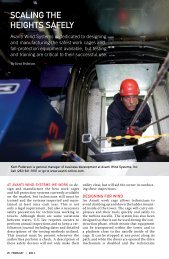Carbon CeramiCs For Current transFer - Wind Systems Magazine
Carbon CeramiCs For Current transFer - Wind Systems Magazine
Carbon CeramiCs For Current transFer - Wind Systems Magazine
You also want an ePaper? Increase the reach of your titles
YUMPU automatically turns print PDFs into web optimized ePapers that Google loves.
cally grooved to guarantee<br />
safe contact and to improve<br />
the cooling of the slip ring<br />
surface. During operation a<br />
protective film is formed on<br />
the slip ring surface, called a<br />
patina. This thin film is crucial<br />
for the current transfer<br />
and the friction behavior of<br />
the carbon brushes. The patina<br />
consists of oxides of the<br />
ring material, humidity, and<br />
graphite from the carbon<br />
brush. Any interference of<br />
the film formation process<br />
has a negative influence on<br />
brush performance. That, for<br />
instance, is ambient temperature,<br />
surface temperature of<br />
the ring, current, humidity,<br />
presence of oil or dust, and<br />
state of the ring surface, etc.<br />
An initially sufficient surface<br />
roughness (5-8µm R z , 0,8-1.2<br />
µm R a ) supports the film formation.<br />
Slip rings are available in<br />
different designs: assembled,<br />
or molded. The diameter and<br />
size is a function of the rotor<br />
current. Variants up to 1500<br />
amperes exist. Intelligent<br />
brush holder systems support<br />
the brushes in their function.<br />
Massive and stable, cast<br />
brush holders are the current<br />
state of the art. Referring to<br />
them as “intelligent” means<br />
that the holders have a brush<br />
wear monitoring device included.<br />
Holder systems with<br />
helical tension springs allow<br />
brushes with 100mm length<br />
and a brush lifetime of more<br />
than two years. The single<br />
holders are normally preassembled<br />
on brush rockers<br />
(fig. 6). Each component of<br />
the current transmission apparatus<br />
can also be adjusted<br />
for offshore usage.<br />
GrounDinG brushes<br />
A special application for carbon<br />
brushes is the discharge<br />
of ripple voltages. Ripple<br />
voltages can arise due to different<br />
factors, with electro-<br />
static effects on the electric circuit and backlashes of the inverter being<br />
the main reasons. Despite constructive measures ripple voltages or<br />
parasitic currents are not completely avoidable.<br />
<strong>For</strong> shaft grounding, a double brush holder with two grounding<br />
brushes is usually used. The standard carbon brush design is a so-called<br />
sandwich design made of a silver metal and graphitic brush grade. The<br />
silver grade is for grounding the graphite parts, for film formation on<br />
the shaft, and the removal of existing oil. It has to be certain that in the<br />
turning direction of the shaft, the graphite layer is always in front of the<br />
silver layer.<br />
windsystemsmag.com 3 1




